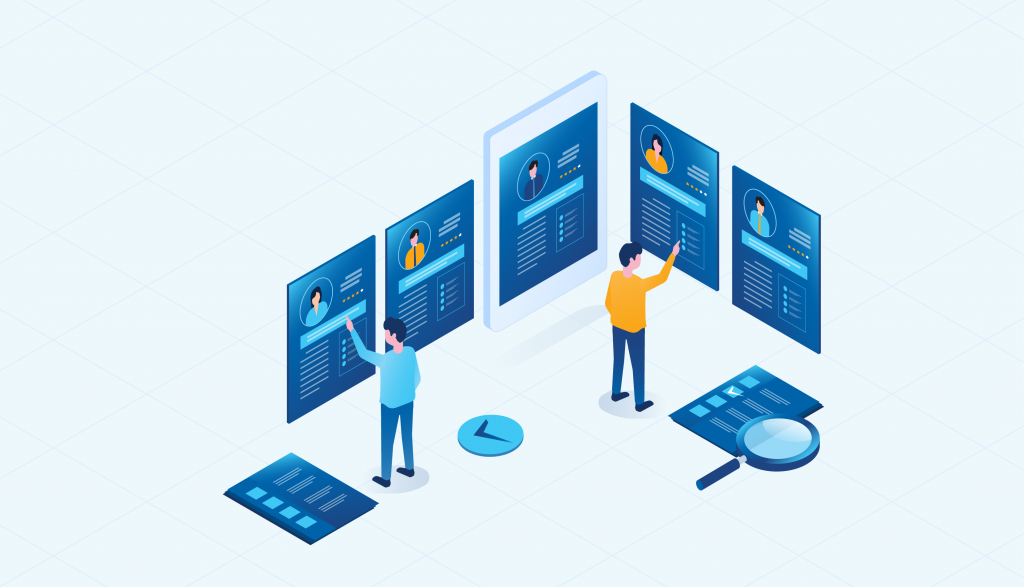Key takeaways
- Most basic HR system features include payroll, benefits administration, time tracking and scheduling, and employee self-service.
- More advanced HR systems offer additional features such as recruiting tools, performance management, learning development, and employee engagement.
- The right combination of features will support your business’s HR goals now and in the future.
With so many human resources (HR) software systems on the market, it can be hard to choose the one that’s best for your business. One company’s perfect set of features may be too much or not enough for another. To make the best choice, it’s important to look for HR system features that will address your business’s current needs while also considering which features might add value down the road.
What features should an HR system have?
The right HR software suite should include the following features as part of its core functionality or as optional add-ons:
- Centralized database
- Employee self-service
- Talent management
- Recruiting
- Onboarding and offboarding
- Payroll and compensation management
- Benefits administration
- Time tracking
- Employee scheduling
- Performance management
- Learning and development
- Employee engagement
- Workforce analytics
- Compliance
Centralized database
Having employee information spread across multiple platforms — or even worse, physical files — is a real inconvenience. One must-have HR system feature that you might not think of is a centralized database like the one from BambooHR. These databases keep employee documentation in one digital space for easy searching and faster auditing, saving your HR team time and effort.
Find the right system for your HR data: The Best HRIS Systems of 2023
Employee self-service
If your HR team is constantly bogged down by employee requests, then look for HR software that offers an employee self-service portal. These portals let employees log in by themselves and take care of HR tasks like clocking in and out, viewing PTO, and downloading tax forms without having to go through HR.
For instance, Paycom offers a dedicated mobile app that is just for employee self-service, reducing the burden on the HR team:
Check out our list of solutions that help small teams operate more efficiently: Best HR Software for Small Business
Talent management
Talent management refers to planning for and meeting future human capital needs. It covers a wide range of more specific activities like recruiting and performance management. Some software systems combine all their HR systems under a “talent management” umbrella, while others break them down into more specific categories.
For example, Rippling’s talent management features include tools for recruiting, onboarding, learning, and employee engagement. When shopping for new HR software, it’s always a good idea to confirm exactly what features are included under the “talent management” header so that you know you’re getting the functionality your team needs.
Learn more about software suites that cover the entire employee lifecycle: Top HR Management Systems (HRMS) Software
Recruiting
Recruiting features help internal HR teams or external recruiting agencies find and hire quality candidates. Applicant tracking systems (ATS) automate much of the recruiting process, including posting to various job boards, sourcing promising candidate profiles, and sorting through resumes based on keywords. They also offer tools for scheduling interviews and rating and reviewing candidates.
There are many different standalone applicant tracking systems available, but you can also find some HR software platforms that also include ATS functionality. JazzHR, one of the more popular standalone ATS, makes it easy for the whole team to collaborate during the hiring process and also includes features for texting candidates and creating custom reports.
Find the right software that will help you grow your team: The Top Recruiting Tools for Effective Employee Hiring
Onboarding and offboarding
Onboarding and offboarding aren’t the most glamorous parts of the employee lifecycle, but they are essential for hiring and firing. HR software can generate paperwork to complete either process and offer e-signature capabilities so you don’t have to fuss with paper copies. Some HR systems also offer additional features that allow your IT team to set up or decommission employee devices like phones and laptops.
For example, Freshteam by Freshworks makes it easy to onboard employees thanks to an onboarding checklist, welcome kit, automated emails, and document sharing. It also provides offboarding templates to make the separation process faster and easier for everyone involved.
Payroll and compensation management
Payroll features don’t just help your team run payroll each week or month, they also make it possible to view employee salary history, implement pay bumps, handle taxes, and more. No matter the size of your company, choosing an HR system that includes payroll — such as Gusto — can significantly reduce the administrative burden and even fully automate payroll in some cases.
Looking for dedicated tools to pay employees? Read: Top Payroll Software
Benefits administration
Regular paychecks are only part of a global compensation strategy, which is why benefits administration is another key HR system feature. Platforms such as Zenefits help your team browse benefit plans, collaborate with a broker, manage open enrollment, and streamline the benefits selection process for employees.
Time tracking
If you pay employees or bill clients by the hour, then you will definitely need time tracking as an HR system feature. In fact, many HR platforms such as Paycor include time-tracking features that let employees clock in and out from anywhere while giving managers and HR teams the necessary tools to review timesheets and maintain compliance. Then the data can automatically flow over to payroll so your team doesn’t have to calculate pay manually.
Employee scheduling
In addition to time tracking, some businesses also need employee scheduling software to track employee availability, manage shift schedules, and plan adequate coverage for the busiest operating times. Sage HR makes this easy with a colorful, drag-and-drop shift management feature that also allows managers to categorize employees by location or role. It also includes a self-service portal that allows employees to mark when they can and can’t work.
Performance management
Performance management goes way beyond the traditional annual review. The right software will offer reminders for other regular check-ins, provide templates for performance ratings and rubrics, offer coaching resources for supervisors, and more.
For instance, SAP SuccessFactors started as performance management software before adding other features, and it offers one of the most rigorous performance management modules on the market. In addition to all the features listed above, it suggests verbiage to prompt managers when writing reviews and setting goals for both individuals and teams.
Learn more about the tools that can help you identify and grow your top employees: Top Performance Management Software
Learning and development
Learning management systems (LMS) help HR teams identify training needs, automate qualifications and training compliance, and offer self-service tools for employees to educate themselves.
For example, the learning module in Oracle Fusion Cloud HCM recommends personalized training courses to each employee based on their individual skills and career goals. HR teams and managers can identify opportunities to help employees grow, and employees can share their own expertise with their peers in a collaborative learning environment.
Find the top software that can help train your staff: Best Corporate Learning Management Systems
Employee engagement
Employee engagement functionality allows you to gather anonymous feedback, identify areas for improvement, and measure employee morale and satisfaction over time. In many instances, these features also support peer recognition and other elements that create strong engagement among employees.
The workforce management platform Workday actually offers a continuous learning platform that integrates with any human capital management (HCM) software, called Workday Peakon Employee Voice. Peakon lets companies gather and analyze employee feedback and also compares their benchmarks to similar organizations to see who they stack up.
Workforce analytics
In an increasingly data-driven world, workforce analytics is rapidly becoming a critical HR system feature. HR analytics tools help your team track key performance indicators (KPIs) and visualize them in charts. This information can then be used to assess performance at the individual, team, department, and company levels.
Analytics features in robust HR suites like ADP combine data from multiple sources, including payroll, recruiting, and performance management modules. ADP also integrates with a wide range of third-party platforms, which gives HR leaders a well-rounded view that enables better decision-making.
Explore solutions that provide advanced workforce analytics: Top Human Capital Management (HCM) Software
Compliance
While HR software is no replacement for legal and tax exports, it can help ensure compliance with all relevant local, state, federal, and international laws. For example, Namely provides law and compliance alerts, a state policy comparison tool, OSHA logs and reporting, and other compliance features to help mitigate risk.
Which HR system features are most important?
The most important HR system features for your business are the ones that address the biggest challenges your HR team faces.
For example, time tracking and payroll may be the top priority for a business that’s just starting out. In contrast, a business that’s focused on growing its workforce may be more interested in people analytics and talent management features.
In either case, it’s important to consider the tools needed to overcome HR hurdles today while also thinking about the technology that will help your team meet its goals in the future. Identifying these must-have and nice-to-have features will make the HR software buying process much smoother.
If you’ve identified the HR system features you need, check out our HR Software Guide to explore top vendors. Or, if you’re still not sure what software you need, watch this video to understand the five main types of HRIS solutions on the market:





